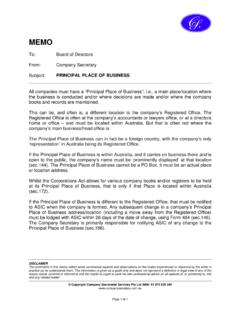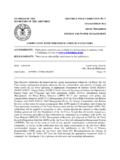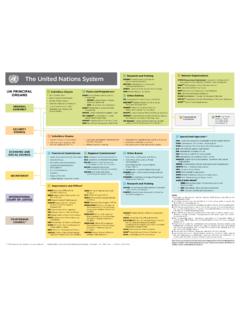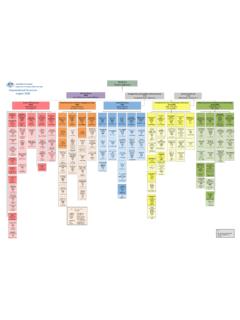Transcription of BY ORDER OF THE AIR FORCE INSTRUCTION 90 …
1 BY ORDER OF THE AIR FORCE INSTRUCTION 90-1001. secretary OF THE AIR FORCE . 9 JANUARY 2017. Special Management PLANNING TOTAL FORCE . ASSOCIATIONS (TFAS). COMPLIANCE WITH THIS PUBLICATION IS MANDATORY. ACCESSIBILITY: Publications and forms are available on the e-Publishing website at for downloading or ordering. RELEASABILITY: There are no releasability restrictions on this publication. OPR: AF/A8XF Certified by: AF/A5/8. (Lt Gen James M. Holmes). Supersedes: AFI90-1001, 29 May 2007, Pages: 31. 25 April 2008. This INSTRUCTION implements Air FORCE Policy Memorandum (AFPM) 90-10, Total FORCE Integration, 27 October 2016 for planning Total FORCE Associations (TFAs) and the development of Total FORCE Association Proposals (TFAPs). It applies to all Air FORCE components, Regular Air FORCE (RegAF), the Air FORCE Reserve (AFR), and the Air National Guard (ANG).
2 For the purpose of this INSTRUCTION , the National Guard Bureau (NGB) functions as both a Headquarters Air FORCE (HAF) 2-letter and a Major Command (MAJCOM) equivalent. Refer recommended changes and questions about this publication to the Office of Primary Responsibility (OPR). using AF Form 847, Recommendation for Change of Publication. This publication may be supplemented at any level, but all supplements must be routed to the OPR of this publication for coordination prior to certification and approval. Requests for waiver to this INSTRUCTION will be forwarded to AF/A8XF for consideration. Ensure all records created as a result of processes prescribed in this publication are maintained in accordance with (IAW) Air FORCE Manual (AFMAN) 33-363, Management of Records, and disposed of IAW the Air FORCE Records Disposition Schedule (RDS) in the Air FORCE Records Information Management System (AFRIMS).
3 SUMMARY OF CHANGES. This document has been substantially revised and must be completely reviewed. Major changes include guidance to MAJCOMs and HAF organizations for planning TFAs within the context of the Strategy, Planning, and Programming Process (SP3). Specifically, it replaces the 1) Initiative Review Worksheet (IRW) and 2) Integration Plan (I-Plan), with a single Association Plan (A- 2 AFI90-1001 9 JANUARY 2017. Plan). This INSTRUCTION also eliminates the Total FORCE Enterprise Working Group (TFEWG) and Total FORCE Enterprise Evaluation Group (TFEEG) and replaces them with a single HAF board, Total FORCE Evaluation Board (TFEB), that will provide a final HAF review and approval of all TFAPs. This document removes the requirement for biennial reviews of A-Plans. Continuing, this INSTRUCTION defines partnering MAJCOMs, to include the Sponsor-MAJCOM and Associate- MAJCOM(s) and directs the partnering MAJCOMs to coordinate with the HAF functional staffs and Core Function Leads (CFLs) during the development of the Business Case Analysis (BCA).
4 And A-Plan. Furthermore, it substitutes host units and associate units with Sponsor Organizations and Associate Organizations to facilitate associations involving both unit and non-unit entities, including associated detachments. This INSTRUCTION reduces the context of TFAs to only two types: Classic Association (CA) and Active Association (AA). Finally, this document does not address operational or managerial issues concerning TFAs; operational and management issues are the purview of AF/A3, the partnering MAJCOMs, wings, groups, and the Sponsor and Associate Organizations. Chapter 1 OVERVIEW 4. Background.. 4. 4. Applicability.. 4. Objective.. 4. Chapter 2 ROLES AND RESPONSIBILITIES 5. HAF Responsibilities: .. 5. MAJCOM Responsibilities: .. 8. Air FORCE Installation and Mission Support Center (AFIMSC).
5 8. Core Function Leads (CFLs).. 8. Chapter 3 TFAP PLANNING 9. TFAP Planning Overview.. 9. DSD.. 9. Table Manpower Table Template.. 9. 11. TFAP Submission to HAF.. 11. Chapter 4 TFAP REVIEW 12. Overview.. 12. TFAP Review Process.. 12. AFI90-1001 9 JANUARY 2017 3. Figure TFAP Review.. 12. Total FORCE Evaluation Board (TFEB).. 12. Chapter 5 TFA ASSESSMENTS 14. Assessments.. 14. Disassociation.. 14. Attachment 1 GLOSSARY OF REFERENCES AND SUPPORTING INFORMATION 15. Attachment 2 ASSOCIATION PLAN (A-PLAN) FOR CLASSIC/ACTIVE. MDS/MISSION SET ASSOCIATION AT BASE NAME AFB, STATE 23. Attachment 3 DISASSOCIATION MEMORANDUM TEMPLATE 31. 4 AFI90-1001 9 JANUARY 2017. Chapter 1. OVERVIEW. Background. The United States Air FORCE 's (USAF) Total FORCE (TF) includes the RegAF, ANG, AFR, civilian and contractor workforce, and Civil Air Patrol (CAP) when conducting missions for the Air FORCE as the official Air FORCE Auxiliary; each offers unique capabilities and strengths.
6 The Air FORCE utilizes all of its contributing components in varied capacities to meet the Nation's National Military Objectives. Associations are one way the Air FORCE leverages the TF to meet these objectives efficiently and effectively. Scope. The Air FORCE Strategic Master Plan (SMP) identifies Agility and Inclusiveness as two strategic imperatives driving fundamental change in the nature of the Air FORCE . To maximize utility, the Air FORCE must find creative ways to optimize the existing FORCE structure to meet mission demands with constrained resources and to dominate our adversaries in an increasingly dynamic environment. TFAs provide a construct for the USAF to optimize the existing FORCE structure aligned with the tenets of Agility and Inclusiveness described in the SMP.
7 TFAs are formal agreements between two or more USAF component organizations to share resources to perform a common mission. Applicability. This publication applies to the planning of all TFAs. The relationship between the CAP and the USAF is carefully defined by federal law (see Title 10, United States Code ( ), Sections 9441-9448); therefore, Total FORCE options involving the CAP are not governed by this INSTRUCTION . AFI 10-2701, Organization and Function of the Civil Air Patrol, details the procedures for employing the CAP and the circumstances under which CAP may perform Air FORCE -assigned missions in its role as a volunteer civilian auxiliary of the USAF. Objective. The objective of this INSTRUCTION is to outline roles and responsibilities, definitions, and the planning process for development and assessment of TFAs.
8 AFI90-1001 9 JANUARY 2017 5. Chapter 2. ROLES AND RESPONSIBILITIES. HAF Responsibilities: The General Counsel for the Department of the Air FORCE (SAF/GC). SAF/GC will provide legal guidance, advice, and direction to TFAPs and TFAs regarding significant policy, legislative, Department of Defense (DoD), interagency, Foreign Military Sales (FMS), fiscal law, ethics, and Base Realignment and Closure (BRAC) implications under consideration by the partnering MAJCOMs and in coordination with AF/A8XF. Assistant secretary of the Air FORCE for Manpower and Reserve Affairs (SAF/MR). SAF/MR will provide TFA guidance, oversight, and direction with regards to manpower, military and civilian personnel, Air Reserve Components (ARC), and readiness support for the Department of the Air FORCE . SAF/MR will assist in reviewing TFAPs under consideration by the partnering MAJCOMs and in coordination with AF/A8XF.
9 Assistant secretary of the Air FORCE for Financial Management and Comptroller (SAF/FM). SAF/FM will provide TFA guidance, oversight, and direction on all matters pertaining to funding issues associated with TFAPs and TFAs. SAF/FM will assist in reviewing TFAPs under consideration by the partnering MAJCOMs and in coordination with AF/A8XF. Assistant secretary of the Air FORCE for Information Dominance and Chief Information Officer (SAF/CIO A6). SAF/CIO A6 will provide TFA guidance, oversight, and direction on all matters pertaining to Information Technology and Cyberspace Information and Systems. SAF/CIO A6 will assist in reviewing TFAPs under consideration by the partnering MAJCOMs and in coordination with AF/A8XF. Assistant secretary of the Air FORCE for Installations, Environment, and Energy (SAF/IE).
10 SAF/IE will provide policy guidance, oversight, and direction on all matters pertaining to installations, environment, and energy. The SAF/IE Strategic Basing Office (SAF/IEIB) is the HAF lead agent for strategic basing actions in accordance with AFI 10-503, Strategic Basing. SAF/IE will review TFAPs under consideration by MAJCOMs. SAF/IE Base Realignment and Closure (BRAC) Program Management Office (PMO) will lead NGB directly in coordinating all Guard BRAC actions, since only the NGB can communicate directly with the state on behalf of the Department of the Air FORCE . SAF/IE and the partnering MAJCOMs will coordinate TFAPs with the appropriate Air FORCE Installation and Mission Support Center (AFIMSC) or ARC to ensure proper support costs are aligned to meet program requirements for TFAs.















